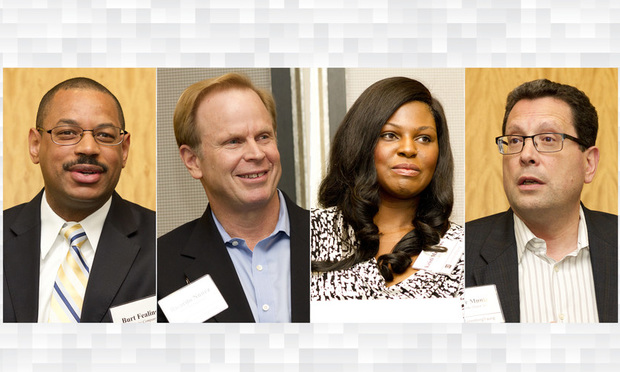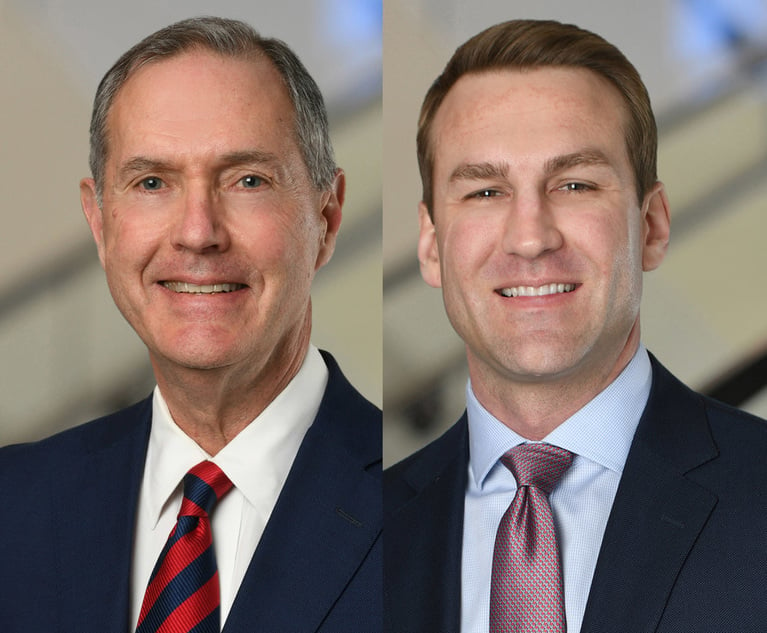For More Diversity, In-House Legal Leaders Say: Be Intentional, Show Bottom-Line Benefits
On May 18, a group of attorneys from major companies gathered in the Atlanta offices of Greenberg Traurig to share their experiences with building diversity.
May 21, 2018 at 01:56 PM
4 minute read
The original version of this story was published on Corporate Counsel
 L-R Burt Fealing, Ricardo Nunez, Kristi Matthews and Peter Muniz. Photo credit: John Disney/ALM.
L-R Burt Fealing, Ricardo Nunez, Kristi Matthews and Peter Muniz. Photo credit: John Disney/ALM. When it comes to diversity and inclusion, efforts to improve have to be intentional.
That was one of the major takeaways from a panel discussion on diversity May 18 in Atlanta that featured in-house legal leaders from top companies.
“It takes a lot of work and a lot of energy, and you have to be very conscientious of it all across the organization,” said Burt Fealing, executive vice president, general counsel and corporate secretary at Southwire Co.
“You have leadership who are very interested in making the change or you have individuals who are early in their career who are very interested in making the change, and then you have the layer in between, and that's where great initiatives can fall apart,” he said.
Fealing and other in-house attorneys spoke to lawyers and members of diverse law student groups from various Atlanta schools at Greenberg Traurig's annual Associates Committee for Diversity & Inclusion Speaker Series. In addition to urging attendees to be conscientious about their efforts to increase diversity and inclusion, the panelists offered some additional insights.
Be Aware of the Difference Between the Two
“Diversity is basically being invited to the party, and inclusion is basically being asked to dance,” said Ricardo Nunez, GC at SWM International, summing up the distinction between the two concepts.
Kristi Matthews, senior labor and employment counsel at Newell Brands, added, “Diversity is making sure we have different thoughts, perspectives, walks of life, and inclusion is making sure those thoughts are welcome. It's one thing to be in the room. It's another to be heard.”
Encourage 'Cognitive Diversity'
Panelists emphasized that another important type of diversity is making sure people with varying career and academic backgrounds have the chance to get hired.
Matthews said her route in-house, for instance, wasn't necessarily the traditional one. Before joining Newell in 2015, she spent more than eight years not in Big Law but in government as senior counsel for labor, employment and litigation for the city of Atlanta.
And it's not just in its legal department where consumer goods company Newell has “opened the pathways” to getting a foot in the door, Matthews said.
For positions in various departments, the company started considering college students and graduates with “other majors, and that has opened up a wealth of diverse audiences,” she said. “And we are seeing the benefits now.”
Peter Muniz, VP and deputy GC at The Home Depot Inc., frames it as “cognitive diversity”—the inclusion of people with different sets of experiences and skill sets. Doing so, he said, helps set the right tone and culture at the top.
The term “'cognitive diversity' resonated more with the business team,” he said. “They understood how people with different sets of experiences and skill sets is good for business.”
Be Able to Measure Diversity in Dollars and Cents
It likely will take more than framing the issue in a certain way for everyone in a particular organization to buy into a shift in values that emphasize diversity and inclusion, the panelists agreed. It comes down to the bottom line, they said.
“You've got to measure it; you've got to track it and get it exposed to the highest levels of the organization,” Muniz said. “If you don't measure it, it's not going to get done. You're going to hear a lot of platitudes, but it's just not going to get done.”
This content has been archived. It is available through our partners, LexisNexis® and Bloomberg Law.
To view this content, please continue to their sites.
Not a Lexis Subscriber?
Subscribe Now
Not a Bloomberg Law Subscriber?
Subscribe Now
NOT FOR REPRINT
© 2025 ALM Global, LLC, All Rights Reserved. Request academic re-use from www.copyright.com. All other uses, submit a request to [email protected]. For more information visit Asset & Logo Licensing.
You Might Like
View All
Law Firms Expand Scope of Immigration Expertise Amid Blitz of Trump Orders
6 minute read
Bass Berry & Sims Relocates to Nashville Office Designed to Encourage Collaboration, Inclusion
4 minute read
Gunderson Dettmer Opens Atlanta Office With 3 Partners From Morris Manning
3 minute read
Trending Stories
- 1Uber Files RICO Suit Against Plaintiff-Side Firms Alleging Fraudulent Injury Claims
- 2The Law Firm Disrupted: Scrutinizing the Elephant More Than the Mouse
- 3Inherent Diminished Value Damages Unavailable to 3rd-Party Claimants, Court Says
- 4Pa. Defense Firm Sued by Client Over Ex-Eagles Player's $43.5M Med Mal Win
- 5Losses Mount at Morris Manning, but Departing Ex-Chair Stays Bullish About His Old Firm's Future
Who Got The Work
J. Brugh Lower of Gibbons has entered an appearance for industrial equipment supplier Devco Corporation in a pending trademark infringement lawsuit. The suit, accusing the defendant of selling knock-off Graco products, was filed Dec. 18 in New Jersey District Court by Rivkin Radler on behalf of Graco Inc. and Graco Minnesota. The case, assigned to U.S. District Judge Zahid N. Quraishi, is 3:24-cv-11294, Graco Inc. et al v. Devco Corporation.
Who Got The Work
Rebecca Maller-Stein and Kent A. Yalowitz of Arnold & Porter Kaye Scholer have entered their appearances for Hanaco Venture Capital and its executives, Lior Prosor and David Frankel, in a pending securities lawsuit. The action, filed on Dec. 24 in New York Southern District Court by Zell, Aron & Co. on behalf of Goldeneye Advisors, accuses the defendants of negligently and fraudulently managing the plaintiff's $1 million investment. The case, assigned to U.S. District Judge Vernon S. Broderick, is 1:24-cv-09918, Goldeneye Advisors, LLC v. Hanaco Venture Capital, Ltd. et al.
Who Got The Work
Attorneys from A&O Shearman has stepped in as defense counsel for Toronto-Dominion Bank and other defendants in a pending securities class action. The suit, filed Dec. 11 in New York Southern District Court by Bleichmar Fonti & Auld, accuses the defendants of concealing the bank's 'pervasive' deficiencies in regards to its compliance with the Bank Secrecy Act and the quality of its anti-money laundering controls. The case, assigned to U.S. District Judge Arun Subramanian, is 1:24-cv-09445, Gonzalez v. The Toronto-Dominion Bank et al.
Who Got The Work
Crown Castle International, a Pennsylvania company providing shared communications infrastructure, has turned to Luke D. Wolf of Gordon Rees Scully Mansukhani to fend off a pending breach-of-contract lawsuit. The court action, filed Nov. 25 in Michigan Eastern District Court by Hooper Hathaway PC on behalf of The Town Residences LLC, accuses Crown Castle of failing to transfer approximately $30,000 in utility payments from T-Mobile in breach of a roof-top lease and assignment agreement. The case, assigned to U.S. District Judge Susan K. Declercq, is 2:24-cv-13131, The Town Residences LLC v. T-Mobile US, Inc. et al.
Who Got The Work
Wilfred P. Coronato and Daniel M. Schwartz of McCarter & English have stepped in as defense counsel to Electrolux Home Products Inc. in a pending product liability lawsuit. The court action, filed Nov. 26 in New York Eastern District Court by Poulos Lopiccolo PC and Nagel Rice LLP on behalf of David Stern, alleges that the defendant's refrigerators’ drawers and shelving repeatedly break and fall apart within months after purchase. The case, assigned to U.S. District Judge Joan M. Azrack, is 2:24-cv-08204, Stern v. Electrolux Home Products, Inc.
Featured Firms
Law Offices of Gary Martin Hays & Associates, P.C.
(470) 294-1674
Law Offices of Mark E. Salomone
(857) 444-6468
Smith & Hassler
(713) 739-1250






